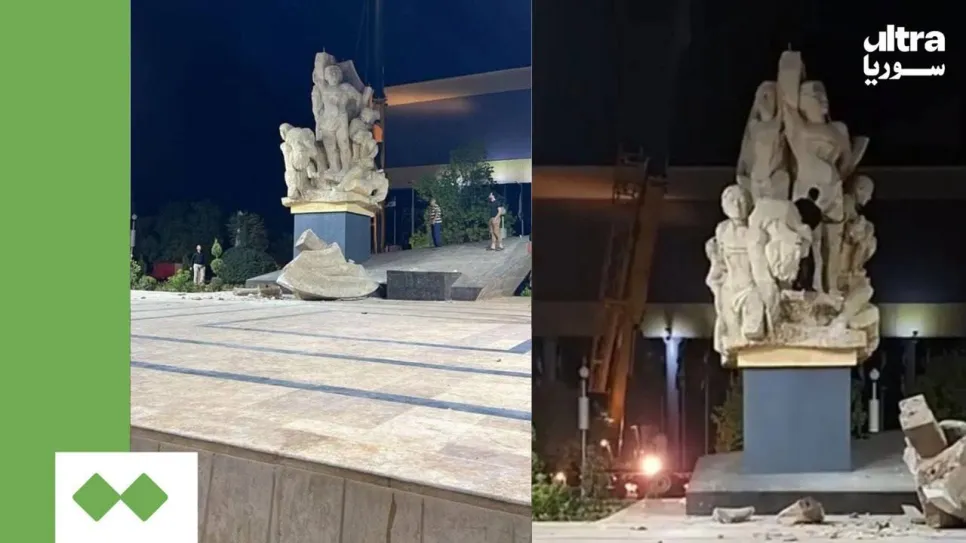In a jarring scene for many residents of Aleppo—though not all, lest I be accused of generalisation—the Statue of Syria’s Martyrs in Saadallah al-Jabiri Square was demolished by contractors working on a public renovation project. The incident, officially described by Syrian authorities as a “technical error,” provoked widespread anger that extended beyond cultural and opposition circles to include ordinary citizens who rarely voice political opinions but felt this time that their city’s identity had been violated.
This monument, contrary to claims by some attempting to justify its destruction, bears no allegiance to the “former regime.” Rather, it commemorates those who fought and died resisting the French occupation and gave their lives for Syria’s independence. These martyrs are not affiliated with any one party or faction—they belong to a shared national past that predates the country’s political and military divisions. It is precisely this inclusivity that made the statue a part of Aleppo’s collective memory. To alter or remove it without consensus is to trespass upon one of the city’s symbolic cornerstones.
More troubling still, the demolition looked more like an act of erasure than restoration. No official announcement or preparatory steps were made to inform the public, and no cultural or municipal authority appeared to oversee the process. Though city officials later promised the statue would be “reinstalled after restoration,” the aggressive dismantling and opaque handling of the affair raised serious doubts and questions about the real motives behind the act—and who, exactly, authorised it without public consultation.
This event cannot be separated from a broader pattern of authoritarian governance increasingly divorced from the public it claims to serve. The prevailing mentality sees all public assets—from history to heritage—as the private property of power. What we witnessed here is part of a repeated pattern in the handling of Syria’s cultural legacy: removal, replacement, and reinterpretation—without consultation, explanation, or meaningful inclusion of those to whom this heritage belongs. While some may dismiss the statue as “ugly” or “outdated,” its value lies not in aesthetic merit but in historical and emotional symbolism—something no authority has the right to distort or monopolise.
Even more concerning was the ideological undertone behind the destruction. Some of those who carried out or defended the removal did so from a rigid religious stance, describing the statue as an “idol” that should not stand in a public space. Such Salafist-inspired views threaten to impose a narrow religious vision on the civic realm, justifying the obliteration of anything that doesn’t conform.
This rhetoric sends a chilling message to anyone—be they Christians, non-Salafi Muslims, or secular citizens—who may not share this worldview. When a monument to fallen heroes is branded “pagan” or “idolatrous,” the conversation moves far beyond cultural debate and enters the realm of cultural cleansing. We’ve seen this script before: in Mosul, in Palmyra, where statues, shrines, and museums were crushed in the name of purity and belief.
The outrage triggered by this incident cut across political lines. Even those broadly supportive of the current authorities expressed dismay. It wasn’t about partisanship—it was about memory, dignity, and the condescending, top-down manner in which the affair was handled, as though no one in the city deserved to be consulted or respected.
This event is a stark reminder of the widening gulf between decision-makers and those forced to live with their decisions. It also points to a growing drive to impose a singular religious, cultural, and political identity upon a city long defined by its diversity, contradictions, and pluralism.
Indeed, the shattering of the statue did not simply remove a monument—it tore through the thin fabric of what remains of Aleppo’s civic space. It was as though the heart of a grieving mother had been ripped out without warning. The people of Aleppo did not mourn a piece of stone for its artistic merit, but because it stood tall when so much else had crumbled—homes, friendships, trust, dreams. The statue bore silent witness to those who faced death with courage, and to those who still struggle to preserve meaning amid the ruins.
And to those who mock the outcry, scoffing that people are “worrying about statues” in a time of hunger and collapse, we say this:
Those who do not feel outrage when their symbols are erased will not flinch when their rights are stolen. The statue was not a luxury—it was a mirror of what remains of a shared conscience. When symbols are erased, meaning collapses. And then, everything becomes replaceable: memory, justice, even the homeland itself.
This article was translated and edited by The Syrian Observer. The Syrian Observer has not verified the content of this story. Responsibility for the information and views set out in this article lies entirely with the author.


